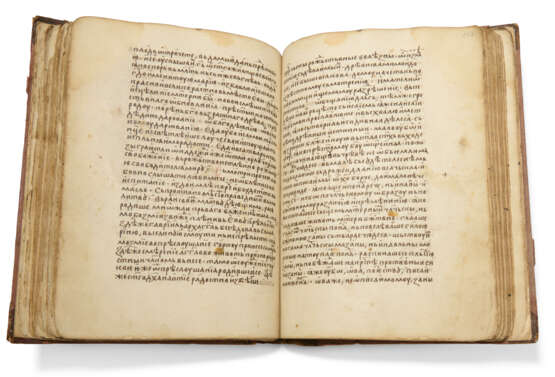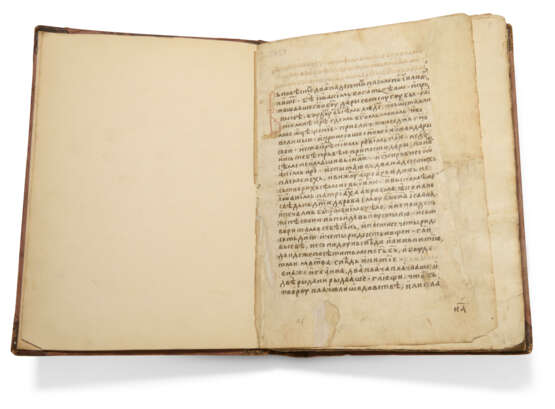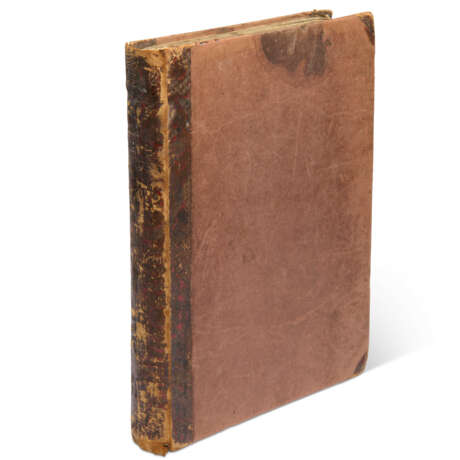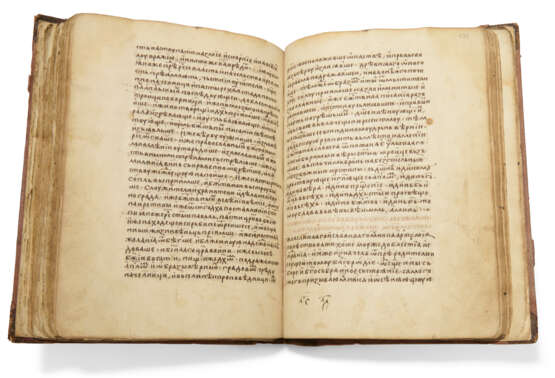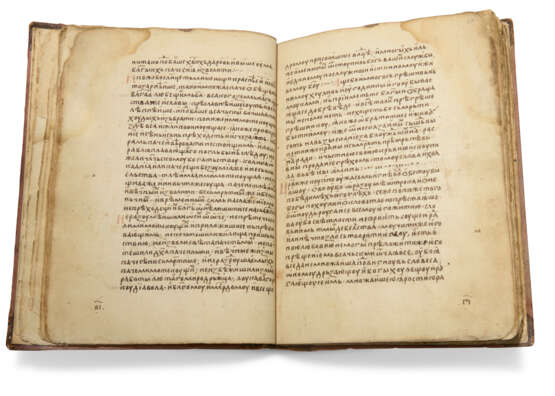ID 1214856
Lot 30 | The Fekula Barlaam and Josephat
Estimate value
£ 30 000 – 50 000
Miscellany of texts, including the story of Barlaam and Josephat, in Serbian Church Slavonic, manuscript on paper [Serbia, early 15th century]
An exceptionally rare, early literary rendition in Church Slavonic of the legend of Barlaam and Josephat, a Christianised version of the story of Siddhartha Gautama who became the Buddha.
285 x 205mm. i (paper) + 173 leaves + i (paper), mostly complete, gathering signatures throughout from '10' ending with '31', modern pencil foliation 1-173 followed here, 28 lines written in Cyrillic semi-uncial in black ink by a single scribe, 1- to 6-line headings and initials in pale red, a few marginal annotations, watermarks very close to Briquet 7 (Udine, 1417) (lacking some leaves, some leaves misbound, some stains and other signs of use and repair, for a full collation contact department). Russian mid-19th-century binding, gilt-stamped half calf over boards, sewn of 4 cords (stained). Fitted box.
Provenance:
(1) Paul M. Fekula (1905-1982): his MS 653, published in Matejic, 1983 and Keenan, 1988. His sale at Sotheby's, Russian Manuscripts from the Fourteenth to the Nineteenth Century From the Paul M. Fekula Collection, 29 November 1990, lot 61, sold for £26,400 to:
(2) The Schøyen Collection, MS 706.
Contents:
The story of Barlaam and Josephat, attributed to St John of Damascus, ff.1-2v continued on ff.88-93v (misbound, quire signature '21' on f.1 and f.93v); Story of Barlaam and Josephat, ff.3-74v, 81-87v, 173-173v (opening section missing, quire signatures for '10' on f.5v [last 3 leaves], '11-19' complete from ff.6-74v, quire '20' misbound [first 7 leaves ff.81r-87v, and final leaf f.173, quire signature '20' on f.81 and just visible in bottom corner of f.173v]); Text from a Homily on the Feast of the Presentation of Theotokos to the Temple, ff.75-80v (end is missing, possibly misbound); Homily on the Feast of the Birth of Theotokos and other Homilies, Eulogies, and other religious Texts, ff.94-172r (beginning missing, quire signature '21' repeated but complete from ff.94-100v, '22-30' complete from ff.101-171v, quire signature '32' on f.125, inserted between '24' on f.124v and '25' on f.126, quire signature '31' on f.172); the other texts in the final section are the Homily for the Nativity of the mother of God, the Homily for the Exaltation of the Cross, the Homily for the Conception of John the Baptist, St Johannes Chrysostom's eulogy of St John the Divine, eulogies for the archangels Michael and Gabriel, the Passion of Artemius, and the Life and Miracles of St. Nicholas.
The majority of the manuscript tells the story of Barlaam and Josephat. The present Slavonic version is a translation from the Greek version of the legend, traditionally attributed to St John of Damascus (c.675-c.749) who adapted the legend from its Persian, Pehlevi tradition. The story of Baarlam and Josephat in fact traces its roots all the way to the life of Siddhartha Gautama, sharing many parallels with the story of the Buddha from the Sanskrit texts: the renunciation of worldly goods by the Indian prince Josephat; his conversion to Christianity during a period of seclusion and isolation; his epiphanic encounter with the hermit Saint Barlaam during his imprisonment; and the ultimate conversion of his remonstrant father King Abenner. Both Abenner and Josephat, much like the Buddha, renounce worldly goods, abdicate their temporal powers, and become hermits, retiring to the desert with the old teacher Barlaam. Etymological echoes testify to this geographic diffusion across the centuries: Buddha (Sanskrit bodhisattva) - to the Middle Persian Bodisav and Arabic Yūdhasaf - to the Greek Ioasaph - to the Latin Iosaphat/Josaphat. Although the Greek, Christian version of the legend is traditionally attributed to the 7th-century monk St John of Damascus, scholars now believe the first Christianized adaptation actually came from the Georgian epic Balavariani, which was then translated by the Georgian monk Euthymius of Athos into Greek in the early 11th century.
Epic literary texts in Church Slavonic are of great rarity, and this early 15th-century manuscript is an incredible testament to the diffusion of the legend in medieval Serbia and the Balkans.
Literature
Keenan, E.L., ed., The Paul M. Fekula Collection: a Catalogue, 1988, Fekula MS.653.
Matejic, M., Slavic Manuscripts from the Fekula Collection: a Description, 1983, F-XXVI.
| Auction house category: | Medieval & renaissance manuscripts, Books and manuscripts |
|---|
| Auction house category: | Medieval & renaissance manuscripts, Books and manuscripts |
|---|
| Address of auction |
CHRISTIE'S 8 King Street, St. James's SW1Y 6QT London United Kingdom | |
|---|---|---|
| Preview |
| |
| Phone | +44 (0)20 7839 9060 | |
| Buyer Premium | see on Website | |
| Conditions of purchase | Conditions of purchase |
